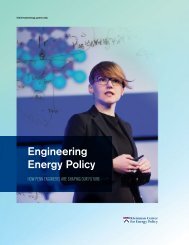2019-Annual-Report
You also want an ePaper? Increase the reach of your titles
YUMPU automatically turns print PDFs into web optimized ePapers that Google loves.
18 Kleinman Center for Energy Policy 2018–2019 Annual Report
ENVISIONING A CLIMATE
ACTION PLAN
The Kleinman Center offers its
vision on how best to address
the climate crisis.
PROJECT TEAM
Mark Alan Hughes, Faculty Director,
Kleinman Center
Oscar Serpell, Research Associate,
Kleinman Center
The Green New Deal is a bold deviation
from previously enacted or proposed
climate action. Earlier attempts at climate
legislation seemed to operate under the
motto “do whatever it takes to reduce
emissions, as long as it doesn’t change
anything.” The Green New Deal asserts
that sufficient climate action requires
a fundamental change to our existing
economic system. The House resolution
has reanimated a long-dormant national
conversation on climate change policy and
this alone is a valuable contribution. Coming
on the heels of—and inspired by—the
Green New Deal, policy experts, politicians,
and thinktanks around the country have
recently contributed their ideas and insights
to the climate conversation, and the
Kleinman Center wants to ensure that we
too are offering our vision for a successful
national response.
Researchers at the Kleinman Center think
that the best way to effectively face the
climate crisis is with a focused climate
action plan rather than an all-encompassing
social, economic, and environmental
overhaul of the U.S. economy. Furthermore,
a climate action plan should offer effective
policy actions with the objective of
eliminating carbon emissions as quickly
as possible. Researchers at the Kleinman
Center have developed a climate action
plan consisting of the following six policy
action areas:
1. Restructuring Federal and State
Taxes and Subsidies
2. Supporting Renewable Energy and
Energy Efficiency Investment
3. Transforming Land Use
4. Protecting Communities
5. Strategically Defending Assets
6. Strengthening Governance
Over the coming year, our team will continue
to further develop this plan and also begin
to research many of the remaining questions
that must be answered before this plan
could be successfully implemented. Some
of these questions are:
Photo by Senate Democrats, via Flickr.
1. What is the most successful strategy
for internalizing the social cost of
carbon on a national level?
2. What are the technical and economic
limitations to changing land use in
the U.S.?
3. What assets can be protected
from natural disaster and the energy
transition and which should be
abandoned or repurposed?
4. What governance changes need
to occur before this plan can
be successfully implemented
and enforced?




